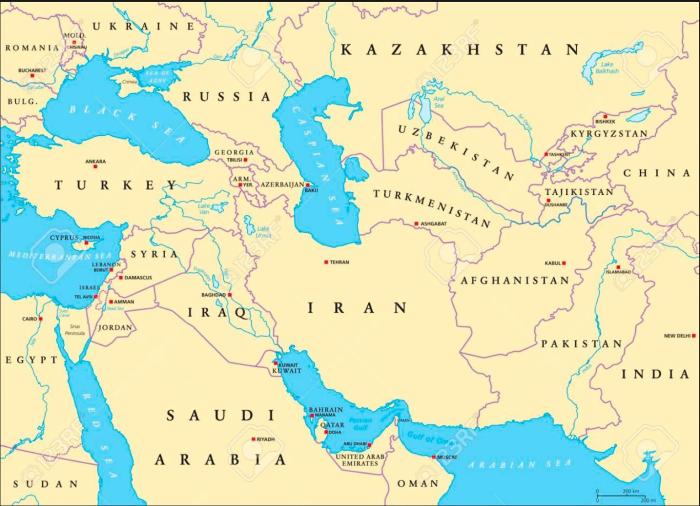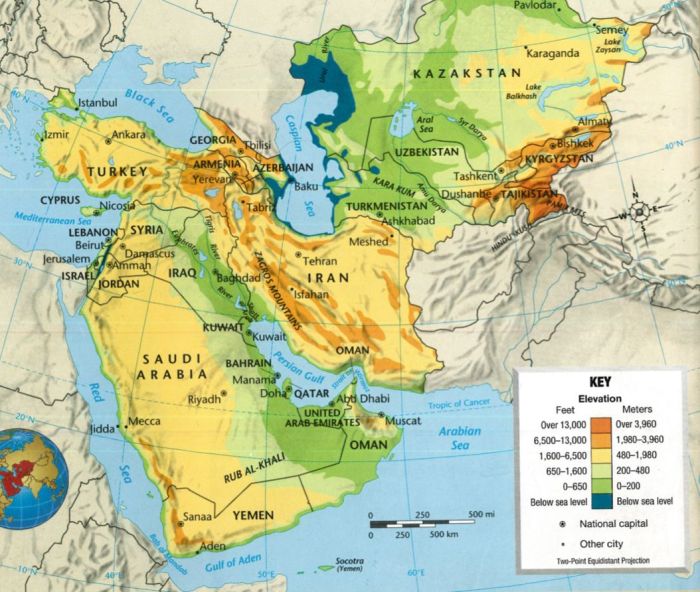The southwest asia bodies of water map provides a comprehensive overview of the major bodies of water found in Southwest Asia. These bodies of water have played a significant role in shaping the region’s history, culture, and economy. This map will serve as a valuable resource for understanding the geography and significance of water resources in Southwest Asia.
The map includes detailed labeling of seas, gulfs, and rivers, providing a clear visual representation of the region’s hydrology. It also highlights the interconnectedness of these water bodies and their impact on the surrounding environment and human populations.
Bodies of Water in Southwest Asia

Southwest Asia is a region located in the western part of Asia, comprising the Middle East and parts of South Asia. It is bordered by the Mediterranean Sea to the west, the Caspian Sea to the north, the Arabian Sea to the south, and the Persian Gulf to the southeast.
The region is characterized by a diverse range of bodies of water, including seas, gulfs, and rivers.
The most prominent body of water in Southwest Asia is the Arabian Sea, which forms the southern boundary of the region. The Arabian Sea is a part of the Indian Ocean and is connected to the Persian Gulf through the Strait of Hormuz.
The Persian Gulf is a semi-enclosed body of water that separates the Arabian Peninsula from mainland Asia. It is a major waterway for the transportation of oil and gas from the Middle East to other parts of the world.
Another important body of water in Southwest Asia is the Caspian Sea, which is located in the northern part of the region. The Caspian Sea is the largest inland sea in the world and is bordered by Iran, Azerbaijan, Turkmenistan, Kazakhstan, and Russia.
The Caspian Sea is a major source of oil and gas for the countries in the region.
In addition to these major bodies of water, Southwest Asia is also home to a number of rivers, including the Tigris, Euphrates, and Nile Rivers. The Tigris and Euphrates Rivers flow through Iraq and empty into the Persian Gulf. The Nile River flows through Egypt and empties into the Mediterranean Sea.
These rivers have played a vital role in the development of human civilization in Southwest Asia, providing water for irrigation and transportation.
Map of Southwest Asia with Labeled Bodies of Water
[Masukan gambar peta Southwest Asia dengan label badan air]
Significance of Bodies of Water in Southwest Asia
The bodies of water in Southwest Asia have played a significant role in the history, culture, and economy of the region.
Historically, the bodies of water in Southwest Asia have been important for trade and transportation. The Persian Gulf and the Arabian Sea have been major trade routes for centuries, connecting the Middle East with India, China, and Africa. The Tigris and Euphrates Rivers have also been important for trade and transportation, providing a waterway between the Persian Gulf and the Mediterranean Sea.
The bodies of water in Southwest Asia have also had a major impact on the culture of the region. The Arabian Sea has been a source of inspiration for poets and artists for centuries. The Caspian Sea has been a major center of fishing and caviar production.
The Nile River has been a source of water and food for the people of Egypt for thousands of years.
In addition to their historical and cultural significance, the bodies of water in Southwest Asia are also important for the economy of the region. The Persian Gulf is a major source of oil and gas for the countries in the region.
The Caspian Sea is also a major source of oil and gas. The Tigris and Euphrates Rivers are important for irrigation, providing water for agriculture in Iraq. The Nile River is also important for irrigation, providing water for agriculture in Egypt.
Challenges and Opportunities Related to Water Management in Southwest Asia
The bodies of water in Southwest Asia are facing a number of challenges, including pollution, climate change, and water scarcity. Pollution from industrial and agricultural activities is a major problem in the Persian Gulf and the Caspian Sea. Climate change is also a major threat to the bodies of water in Southwest Asia, as it is causing sea levels to rise and glaciers to melt.
Water scarcity is a major problem in many parts of Southwest Asia, as the region is one of the driest in the world.
Despite these challenges, there are also a number of opportunities for water management in Southwest Asia. These opportunities include investing in renewable energy sources, such as solar and wind power. These sources of energy can help to reduce pollution and climate change.
Investing in water conservation measures can also help to reduce water scarcity. These measures can include drip irrigation and rainwater harvesting.
Water Disputes and Conflicts: Southwest Asia Bodies Of Water Map

The bodies of water in Southwest Asia have been the source of a number of disputes and conflicts. These disputes have been caused by a number of factors, including water scarcity, pollution, and political tensions.
One of the most significant water disputes in Southwest Asia is the dispute over the waters of the Jordan River. The Jordan River is a major source of water for Israel, Jordan, and the Palestinian Territories. The three countries have been in dispute over the waters of the river for decades.
Another major water dispute in Southwest Asia is the dispute over the waters of the Nile River. The Nile River is a major source of water for Egypt, Sudan, and Ethiopia. The three countries have been in dispute over the waters of the river for centuries.
Water disputes in Southwest Asia are a major threat to the stability of the region. These disputes can lead to conflict and violence. They can also make it difficult for countries to cooperate on other issues, such as economic development and environmental protection.
Potential Solutions and Mechanisms for Resolving Water Disputes in the Region, Southwest asia bodies of water map
There are a number of potential solutions and mechanisms for resolving water disputes in Southwest Asia. These include:
- Negotiation and diplomacy
- International law
- Water sharing agreements
- Water conservation measures
- Investing in renewable energy sources
These solutions and mechanisms can help to reduce water scarcity, pollution, and political tensions. They can also help to create a more stable and cooperative environment in the region.
Top FAQs
What are the major bodies of water in Southwest Asia?
The major bodies of water in Southwest Asia include the Persian Gulf, the Arabian Sea, the Red Sea, the Caspian Sea, and the Tigris and Euphrates Rivers.
How have bodies of water influenced the history of Southwest Asia?
Bodies of water have played a vital role in the history of Southwest Asia, serving as trade routes, transportation corridors, and sources of food and water. They have also been the site of major battles and conflicts throughout history.
What is the economic importance of bodies of water in Southwest Asia?
Bodies of water in Southwest Asia are important for fishing, tourism, and energy production. They also provide water for irrigation and other agricultural purposes.